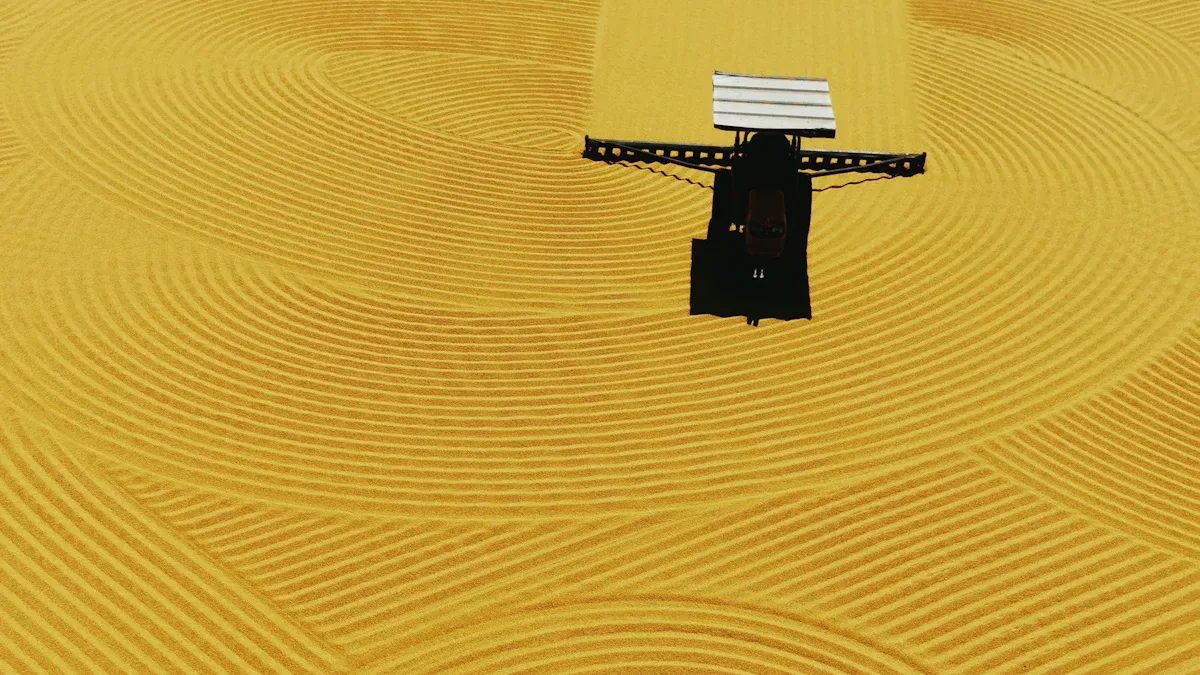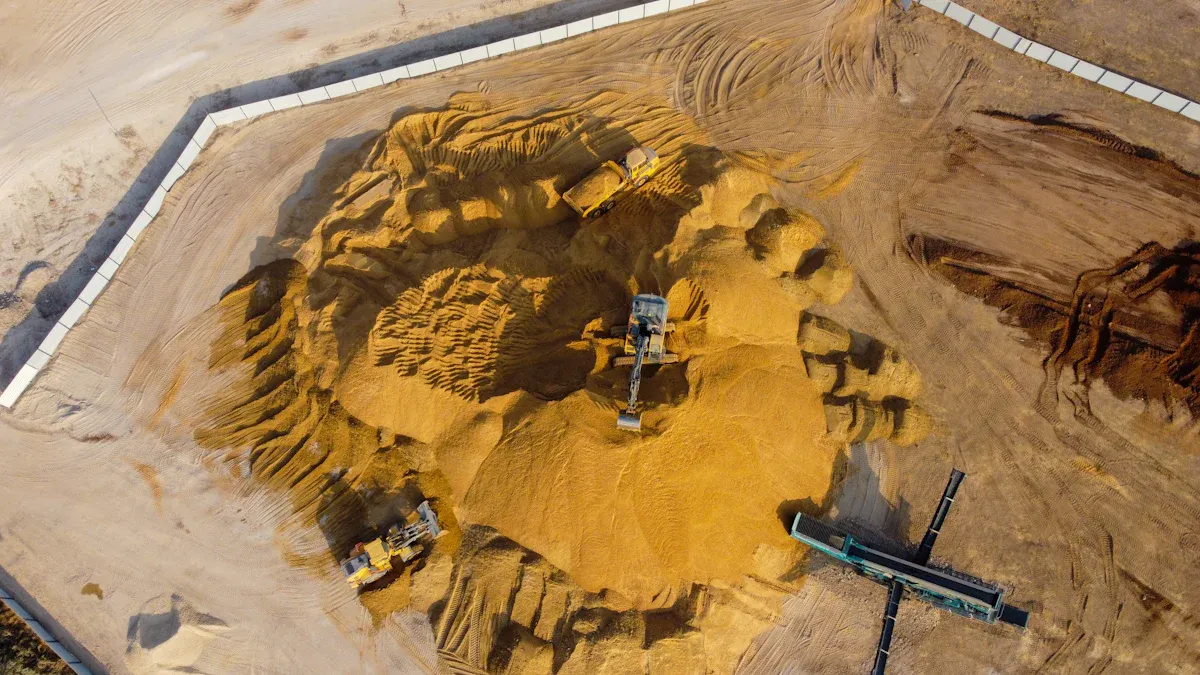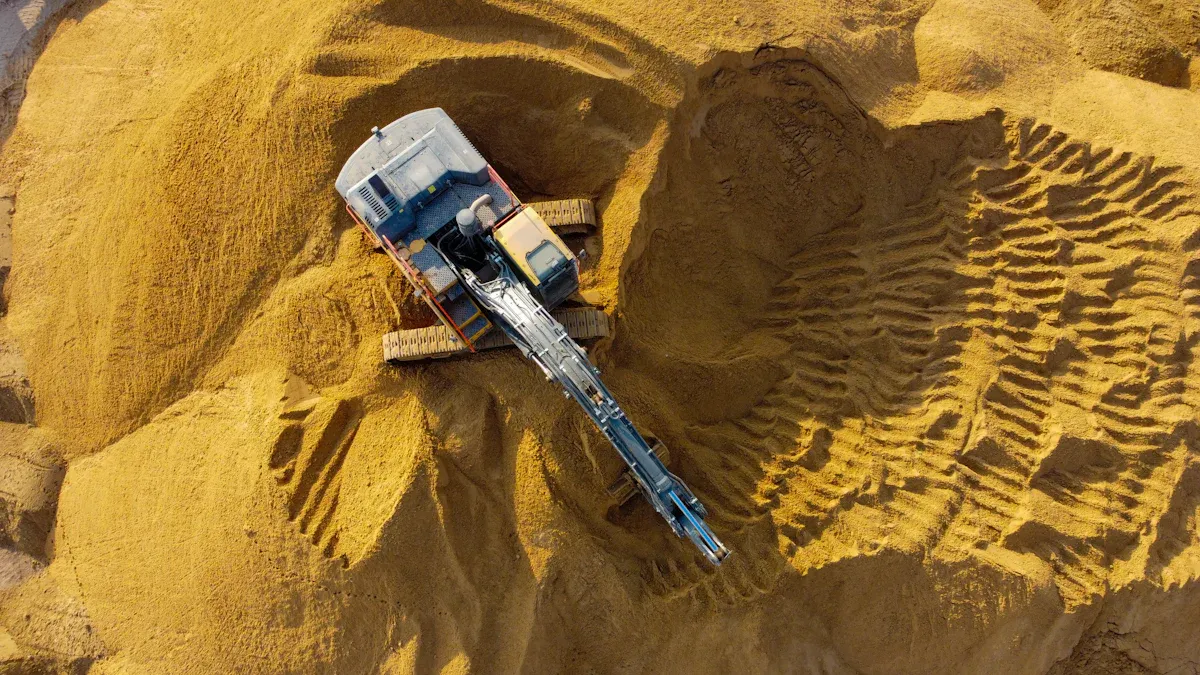
Improving the efficiency of a sand making machine starts with understanding its lining plates. These plates play a critical role in shaping and refining sand particles, making their performance essential. By choosing the right materials, you enhance durability and reduce wear. Regular maintenance ensures the plates stay effective over time. Smart design choices also contribute to better energy use and smoother operation. When you optimize these factors, you not only improve the machine's output but also save on long-term costs.

The material you choose for the lining plates directly impacts the sand making machine's performance and durability. These plates endure constant friction and impact during production, making wear resistance a critical factor. For example, high chromium cast iron offers excellent wear resistance, making it ideal for processing hard and abrasive materials. Martensitic steel provides a balance between toughness and wear resistance, while ceramic composites excel in highly abrasive conditions.
| Material Type | Key Characteristics |
|---|---|
| High Chromium Cast Iron | Excellent wear resistance, ideal for hard, abrasive materials. |
| Martensitic Steel | Higher toughness, good balance of wear resistance and fracture toughness. |
| Ceramic or Ceramic Composites | Used to improve wear resistance in highly abrasive applications. |
| Hardfacing Materials | Extends life of impact plates through welding of wear-resistant materials. |
Wear is a natural result of friction, but selecting the right material can significantly reduce its effects. Research shows that industries relying on sand production benefit greatly from durable materials, as they minimize downtime and ensure consistent quality. By investing in high-performance materials, you can enhance the machine's efficiency and extend its service life.
The design of the lining plates plays a crucial role in optimizing the sand making machine's performance. A well-designed plate ensures even distribution of material, reducing unnecessary wear and improving the quality of the final product. For instance, plates with curved surfaces or strategically placed ridges can guide the sand particles more effectively, minimizing energy loss during production.
You should also consider the thickness and shape of the plates. Thicker plates may last longer, but they can increase the machine's energy consumption. On the other hand, thinner plates might wear out faster but improve energy efficiency. Striking the right balance between these factors ensures optimal performance without compromising durability.
The operating conditions of your sand making machine significantly influence the wear rate of its lining plates. Factors such as material hardness, particle size, and feed rate determine how quickly the plates degrade. For example, processing harder materials or larger particles increases friction, leading to faster wear.
To mitigate these effects, you should monitor the machine's operating parameters closely. Adjusting the feed rate and ensuring uniform material distribution can reduce unnecessary stress on the plates. Additionally, maintaining a clean working environment prevents debris accumulation, which can accelerate wear and lower production efficiency.
Tip: Regularly inspect the machine's operating conditions to identify potential issues early. This proactive approach helps you maintain consistent quality and prolong the life of the lining plates.
Regular inspections are essential for maintaining the efficiency of your sand making machine. By monitoring wear on the lining plates, you can identify potential issues before they escalate. This proactive approach helps you avoid costly downtime and ensures consistent performance. Industry case studies show that wear monitoring tools can predict plate degradation accurately. These tools allow you to schedule maintenance at the right time, minimizing production disruptions.
Benefits of Regular Inspections:
Predict wear patterns and plan maintenance effectively.
Reduce the risk of unexpected machine failures.
Balance the lifespan of lifter and shell plates for cost savings.
You should establish a routine for inspecting the plates. Look for signs of uneven wear, cracks, or thinning. Early detection of these issues can prevent further damage and extend the life of the plates. Regular inspections also help you maintain the quality of sand produced, ensuring your machine operates at peak efficiency.
Debris accumulation can significantly impact the performance of your sand making machine. When debris builds up on the lining plates, it increases friction and accelerates wear. Cleaning the plates regularly prevents this issue and keeps the machine running smoothly. A clean working environment also reduces the risk of contamination in the sand output.
Tip: Use non-abrasive cleaning tools to avoid damaging the plates during maintenance.
To prevent debris accumulation, you should monitor the feed material closely. Ensure that the input materials are free from impurities like stones or metal fragments. Installing protective screens or filters can help keep unwanted debris out of the machine. These simple measures can save you time and money by reducing wear and improving the machine's overall efficiency.
Even with regular maintenance, lining plates will eventually wear out. Timely replacement is crucial to avoid unexpected downtime and maintain production efficiency. Delaying replacement can lead to severe damage to other machine components, increasing repair costs.
When replacing the plates, focus on proper installation techniques. Incorrect installation can cause uneven wear or reduce the plate's lifespan. Follow the manufacturer's guidelines and use high-quality materials to ensure optimal performance. Liner replacement and handling should be done carefully to avoid damaging the machine during the process.
Note: Keep spare plates on hand to minimize downtime during replacement.
By combining regular inspections, cleaning, and timely replacement, you can maximize the lifespan of your lining plates. These maintenance practices not only improve the efficiency of your sand making machine but also reduce long-t erm operational costs.
Using high-quality wear-resistant material is essential for maximizing jaw crusher wear liner performance. Advanced materials like Mn8/SS400 bimetal composites offer significant benefits. Research shows that adding titanium refines the grain structure, increasing hardness. Higher manganese content improves tensile strength and impact resistance. These properties make the material ideal for harsh conditions, such as mining. Under heavy loads, the wear rate stabilizes, reducing by 17%. This improvement lowers maintenance costs and boosts energy efficiency.
Selecting the right material ensures your jaw crusher wear liners last longer. It also minimizes equipment wear, keeping your sand making machine running smoothly. By investing in advanced materials, you reduce downtime and improve overall performance.
Not all jaw crusher wear liners are the same. Customizing liners for specific applications can significantly enhance performance. For example, different types of jaw crusher wear liners are designed to handle varying material hardness and particle sizes. A liner optimized for softer materials may not perform well with abrasive ones. Customization ensures the liner matches the operating conditions, maximizing wear life and efficiency.
You should work with manufacturers to design liners tailored to your needs. This approach helps you address factors affecting jaw crusher wear, such as feed material and operating conditions. Custom liners improve sand quality and reduce unnecessary wear on other parts of the machine.
Proactive maintenance is key to maximizing wear life and avoiding unexpected downtime. Smart technologies, such as sensors and monitoring systems, allow you to track wear in real time. These tools provide valuable data on factors affecting jaw crusher wear, helping you predict when liners need replacement.
For example, smart systems can alert you to uneven wear patterns or excessive stress on wear parts. This information enables you to schedule maintenance before a failure occurs. Predictive maintenance not only extends the life of wear-resistant parts but also ensures consistent performance. By adopting these technologies, you can optimize your sand making machine and reduce long-term costs.
Ignoring early signs of wear can lead to costly consequences. Small cracks, uneven surfaces, or thinning plates may seem insignificant, but they often signal bigger problems ahead. When you fail to address these issues promptly, the wear accelerates, reducing the efficiency of your sand making machine. This can also affect the quality of the sand produced, leading to inconsistent results.
To avoid this, you should inspect the plates regularly. Look for visible damage or unusual patterns on the surface. Using tools like ultrasonic thickness gauges can help you measure wear accurately. Early detection allows you to take corrective action, such as replacing or repairing the plates, before the damage worsens. This proactive approach ensures consistent performance and extends the lifespan of your equipment.
Choosing the wrong materials for your lining plates can compromise their durability and efficiency. Substandard materials wear out quickly, leading to frequent replacements and higher maintenance costs. Incompatible materials may not withstand the operating conditions, causing premature failure.
You should always select materials that match the specific requirements of your sand making machine. For example, high-chromium cast iron works well for abrasive environments, while martensitic steel offers a balance of toughness and wear resistance. Consult with manufacturers or experts to ensure the materials meet your needs. Investing in high-quality materials may seem costly initially, but it saves you money in the long run by reducing wear and improving overall performance.
Improper installation of lining plates can lead to uneven wear and reduced efficiency. Misaligned plates create gaps or overlaps, which increase friction and accelerate wear. This not only affects the machine's performance but also shortens the lifespan of the plates.
To prevent this, follow the manufacturer's installation guidelines carefully. Use the right tools and ensure the plates fit securely in place. Double-check the alignment before starting the machine. Proper installation minimizes wear and ensures the sand making machine operates smoothly. Training your team on correct installation techniques can further reduce errors and improve the machine's reliability.
Tip: Keep a checklist of installation steps to ensure nothing is overlooked during the process.

Advancements in wear-resistant materials have revolutionized the performance of sand making machine lining plates. Recent research highlights the development of boron carbide (B4C) recovery technology, which aims to create a sustainable domestic supply chain for critical materials. This innovation reduces reliance on foreign sources while improving the affordability of hard armor plates. Projects in this area focus on advanced recycling and manufacturing methods, ensuring better economics and sustainability.
| Aspect | Details |
|---|---|
| Technology Area | Materials |
| Objective | Develop the capability to recover boron carbon (B4C) from hard armor ballistic plates. |
| Significance | Reduce reliance on foreign sources and create a sustainable domestic supply chain. |
| Research Focus | Enhance recycling and manufacturing methods for improved affordability. |
| Expected Outcomes | Establish a competitive supply chain, improve plate economics, and reduce foreign dependence. |
These breakthroughs not only enhance the durability of lining plates but also contribute to the long-term efficiency of your sand making machine. By adopting these materials, you can reduce wear and extend the lifespan of your equipment.
Smart monitoring systems have transformed how you approach maintenance for your sand making machine. These systems provide real-time data on wear patterns, allowing you to predict when lining plates need replacement. A full wear map offers a comprehensive overview of the liner profile, helping you optimize equipment settings and reduce unnecessary downtime.
| Benefit | Description |
|---|---|
| Full wear map | Provides a complete overview of wear across the liner profile. |
| Equipment optimization | Balances capacity, settings, power draw, and wear rate using integrated data. |
| Reduced maintenance downtime | Cuts downtime by up to 50% through real-time forecasts for liner change timing. |
| Cost reduction | Eliminates manual inspections, reducing associated costs. |
| Improved safety | Minimizes risks linked to manual inspections in confined spaces. |
| Enhanced sustainability | Maximizes liner material usage, reducing waste and unnecessary changeouts. |
By leveraging these technologies, you can ensure consistent performance and reduce the overall cost of maintenance.
Sustainability is becoming a key focus in the development of sand making machine lining plates. Manufacturers are now exploring eco-friendly materials and processes to reduce environmental impact. For instance, recycling worn-out plates into new ones minimizes waste and conserves resources. Additionally, using renewable energy sources during production further lowers the carbon footprint.
You can also adopt sustainable practices by choosing materials with longer lifespans. This reduces the frequency of replacements, saving both resources and costs. These eco-friendly innovations not only benefit the environment but also align with the growing demand for sustainable industrial solutions.
Tip: Partner with manufacturers who prioritize sustainability to ensure your operations remain environmentally responsible.
Efficient lining plates are vital for the performance of your sand making machine. They reduce wear, improve sand quality, and lower operational costs. By focusing on material selection, regular maintenance, and advanced strategies, you can enhance durability and efficiency. For instance, a municipal wastewater treatment plant reduced waste volume and disposal costs by optimizing its equipment, showcasing the long-term benefits of proper management.
Adopting innovative practices, such as predictive maintenance and eco-friendly materials, ensures consistent performance and cost savings. These steps not only extend the lifespan of your equipment but also align with sustainable industrial goals. Start implementing these strategies today to maximize your machine's potential.
High-chromium cast iron and martensitic steel work well. Ceramic composites are ideal for highly abrasive conditions. These materials resist wear and extend the lifespan of your machine. Always choose materials based on your operating conditions and the type of sand being processed.
Inspect the plates every two weeks or after processing large volumes of material. Regular checks help you spot wear early. Use tools like ultrasonic gauges to measure thickness and identify uneven wear patterns. This prevents unexpected downtime and costly repairs.
Yes, improper installation causes uneven wear and reduces efficiency. Misaligned plates create gaps, increasing friction and wear. Follow the manufacturer’s guidelines carefully. Double-check alignment and secure the plates properly to ensure smooth operation and longer service life.
Debris increases friction and accelerates wear. It also lowers sand quality. Clean the plates regularly and monitor feed materials for impurities. Install protective screens to block unwanted debris. A clean machine ensures consistent performance and reduces maintenance costs.
Yes, manufacturers now offer sustainable options. Recycled materials and renewable energy production methods reduce environmental impact. These plates last longer, minimizing waste and replacements. Partner with eco-conscious suppliers to align your operations with sustainable practices.